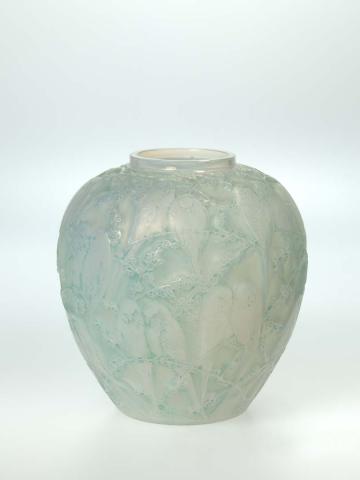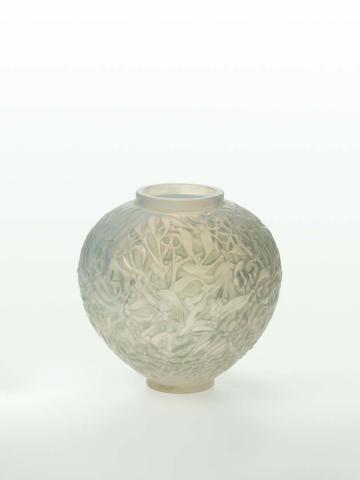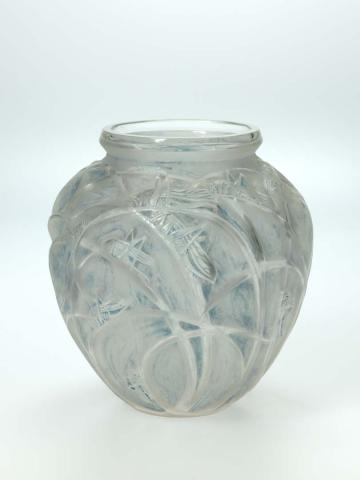ESSAY: 2018.024-30 LALIQUE
By Sophie Rose
April 2018
René Lalique is synonymous with early-modernist design. Originally trained as a jeweller, he discovered glass in the 1890s as a new medium to enhance his intricate designs.1 In 1905, he focused more intensely on glassmaking, and in 1907 was commissioned to design the perfume bottles for François Coty. During his collaboration with Coty, he created bottles adorned with classical female figures, elongated floral patterns and animal motifs, producing iconic Art Nouveau designs.
Until the 1920s, Lalique worked almost exclusively in the 'lost wax' method of casting, making unique works. With strong demand and a burgeoning upper-middle class he changed his production techniques in 1921, opening a factory in northeast France, which still runs today. Flourishing in the interwar period, the glassworks pioneered new mechanized techniques. A site of proto-mass-production, the new factory allowed Lalique to recast his designs in a variety of colours and finishes, from jewel-like red to frosted grey. Some pieces were particularly rare for their hue, transparency or patina and serve as a testament to the flexibility afforded in Lalique’s production methods. By the end of the 1920s, his factory was an epicentre of French decorative art: combining the seemingly disparate poles of luxury décor and mass reproduction.
Many have noted the similarity of Lalique glassware to Japanese ceramic designs.2 Although he cannot be said to match the enthusiasm of 'Japonism' — in which painters, printmakers and furniture designers created a pastiche of Edo-period and French artefacts — Lalique was certainty inspired by Japanese design. While subtle, the influence of Japan enters his jewellery around 1900, and persists in his later glassware.3 His work is perhaps closest to the art of Japan when it employs natural motifs. Bending reeds of grass, swirling schools of goldfish and perched birds all capture the simple elegance of traditional Japanese forms.
Spanning a 20-year period of production, these seven works show the development in Lalique’s design: from pictorial motifs like grasshoppers, fish and birds to abstracted patterns and bulbous textures. Particularly interesting to bring into the Collection is the 1919 Perruches (Parakeet) vase. White glass, stained with a delicate blue dye, the vase is decorated with Australian parakeets (or budgerigars) perched upon flowering branches. From the mid-nineteenth century the parakeet was a fashionable pet amongst the French and English elite. Here, Lalique repeats the bird across the surface of the vase, lending fine textural and tonal variation to the glass. In addition, the image of perched birds amongst fruit blossoms is a common motif in Japanese screens. Perhaps inspired by this tradition, the Perruches (Parakeet) vase combines naturalistic representation with elegant lines of modern design.
Sophie Rose, Assistant Curator, International Art, April 2018
Endnotes
- Bushra Muhammadi, 'René Lalique’s Glass: Second Factory'. Accessed 3 April 2018: http://scalar.usc.edu/works/rene-laliques-glass/index/
- Toyojiro Hida, Japonism in Lalique’s Works' in 'René Lalique, trans. Junko Ando, Keiko Katsuya, Kumiko Nakayama, Keiko Hashimoto, Yoko Hayami and Jeffery D Loucks, Nihon Keizai Shimbun, Inc, Tokyo, 1992, p.39.
- Ibid. p.45.
Connected objects

Davos vase designed 1932
- LALIQUE, René - Creator

Oleron vase designed 1927
- LALIQUE, René - Creator

Beautreillis vase designed 1927
- LALIQUE, René - Creator

Druide vase designed 1924
- LALIQUE, René - Creator


